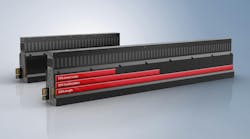Connectivity Trends for Automation Devices
TRANSCRIPT
Automation World — David Greenfield
Welcome to the automation world get your questions answered podcast where we connect with industry experts to get the answers you need about industrial automation Technologies. I'm David Greenfield, editor in chief at automation world. And in this episode, we'll be looking at connectivity trends for automation devices. And joining me to explore this topic is Nizario Biala, with Harding, a supplier of electrical connectors and communication components. So thanks for joining me as reo.
Harting - Nazario Biala
Thanks for having me, David.
Automation World — David Greenfield
So Nazario You know, since the industrial internet of things and industry 4.0 are ultimately all about connecting equipment and systems to better share and analyze data. How have you seen this impact the design of core automation devices such as sensors, controllers, and drives?
Harting - Nazario Biala
So great question, David, with a strong focus on big data analytics, IoT and industry for that oval, require modern manufacturing facilities to generate and collect more data for machine learning AI as well as predictive maintenance. So it stands to reason that more automation devices will need to be installed to generate and collect more data. And this is where it gets interesting, because from the standpoint of plant managers, capital improvements today are not so much on expanding their plant size, but rather on squeezing as much production as humanly possible from their existing capacity and equipment. So what this means is that the footprint of the machines and manufacturing facilities are standing pat, they're not getting any bigger. And because the footprint of the machines and the facilities themselves are not going to get bigger. Well, that means that the automation devices will need to get smaller so that more of them can be installed in different parts of the manufacturing facilities to generate and collect more tangible data come in with space being a premium, these quote unquote, automation that these smaller automation devices are now installed in areas that gosh, engineers would not install them in the past. So as a result, automation devices now need to be more robust to handle harsh environments, such as high shock and vibration and corrosion as a couple of examples. But here's the kicker, David, just because the devices are getting smaller, it doesn't mean that they will have less functionalities, it's actually the other way around. The new automation devices will be asked to do more, for example, automation devices will be required to have higher data rate capability to support increasingly higher demands on the processing speed of field data in applications such as, again, like edge computing, to name a few, reaching anywhere from gigabit to 10 gigabit transmission speeds. And the thing, David is that the new requirements and automation devices extends to the components used in these devices. In the case of connectors, there will also need to be more compact support increased functionality, such as the higher data rate that we talked about earlier, and be able to withstand adverse environments such as high shock and vibration, as well as corrosion.
Automation World — David GreenfieldSo this is a you would say, I guess, from your point of view, there's an overall trend towards I guess the best word for it is miniaturization in components because of you know, space on the plant floor, is that a correct assessment that you would say overall is one of the biggest changes or are there other factors?
Harting - Nazario BialaNo, you're on point, David, it's because again, because the plants are not getting any bigger. And the fact that you need to collect more data, well, you need to put more of these automation devices in places that maybe you wouldn't, you wouldn't even have even thought of and that's why it's really a combination of a couple of things like we had talked about its miniaturization, that's one aspect of the requirements but also the new capabilities such as supporting higher data rate and maybe even more communication channels. And then because of where you're going to be putting these automation devices, places that maybe you wouldn't even thought of before you're now exposing them into harsher environments. So as a result, they need to be more robust.
Automation World — David Greenfield
Okay, understood. So, you know, with the greater use of Ethernet ports that are obviously a key component of these systems as they've been adapted for industry 4.0 And the industrial internet of things. How would you say that this change with a greater incorporation of that level of connectivity has affected industrial connectivity requirements overall beyond the harsh environment adaptations that she spoke about?
Harting - Nazario Biala
Yeah, sure. So, the required requirements brought on by an increased use of Ethernet ports to sport industry for that all has had a huge effect in the connectors required to support Ethernet. And let's look at the RJ 45 To illustrate the much needed change. So, as we know, RJ45 is long been considered the de facto connector to support Ethernet and MS commonly known as the most widely used conductor in the world. But if we think about rj 45, let's face it, RJ45 was originally designed for office environment and never intended for the rugged environment of industrial automation. So as a result due to its lack of robustness, for instance, broken tabs, locking tabs and occasional contact problems. Many users have a love hate relationship with RJ45. And when you factor in the increase requirement for smaller automation devices, well, the size of RJ45 puts a limit on the miniaturization possibility. So given that the industry is ripe for a new connectivity solution that specifically intended for the automation world, meaning that it's more robust, and at the same time can support the higher date high data rate requirement of industry for Dido which we touched on earlier. And lastly, support miniaturization. And the thing is David, as we look at the connectivity market landscape today, we are starting to see solutions, such as the ix industrial connect connector that address the challenges that the industry has faced with RJ45 for years. So let's talk a little bit about the ix industrial connector. It's actually 75% smaller than the form factor of RJ45 and can support cat six a performance for 10 gigabits per second Ethernet. It's fully shielded and is in tested to to withstand railway, standard shock and vibration requirements and can support up to 5000 Meeting cycles. So we're talking about a small and robust connector that can support the high data requirement of Industry 4.0, but more importantly, it's specifically designed for the industrial automation environment. And as of today, we are starting to see increase usage of the IX industrial connector in automation devices such as vision cameras, control modules, as well as servo drives.
Automation World — David Greenfield
Thanks for explaining that Nazario. Now, you know, we've been talking about the impact of the industrial internet of things in industry 4.0 on automation devices and their related connectivity requirements. But can you provide some more details about these new functionalities required to support IIoT and industry 4.0 And and what that means for the connectors that engineers specify for their equipment?
Harting - Nazario Biala
Great question. And as we touched on in the first question, the key aspect of IoT and industry for that always connectivity, again bringing together in machine and human based on extensive real time data gathering and optimized machine intelligence. Now, in my eyes, there are three key elements for a successful implementation of industry 4.0 and the industrial internet of things within a manufacturing environment, which are modularization, miniaturization and digitalization. And each of these elements greatly influenced the connectivity solutions required to support IoT and in this stream for that so if you look at modularization let's let's start there, right so as Industry 4.0 and an IoT take hold forward thinking manufacturing companies will will embrace these technologies and rightfully so. Because these technologies allow them to make higher quality products more efficiently, and react more quickly to shifting consumer demands. And this is key because as we look at our rapidly growing population in the millennials, this generation expects tailored products that match their personal preferences. So product personal is decision is key. And several studies have shown that brands that offer personalized products typically enjoy 50% Higher loyalty rate. Again, that's 50% Higher loyalty rate. Unfortunately, traditional manufacturing methods are designed for mass production and not customization. So as we look at modern manufacturing, a marginally constructed production plant offers greater flexibility in production, where, for instance, each section of the factory can now be individually access and maintain giving manufacturers the ability to change individual production modules without disrupting other processes. So modularity is good, right? But these modular manufacturing line must allow for fast installation changeover and easy maintenance. And this is where connectors come into play. If you look at the connector market landscape today, David, there are many solutions that enable modularity. For instance, if you look at a typical conveyor line, where it's prox, photo eyes, IO links and vision cameras, you'll see tons of M 12s. That allow for easy installation of these devices. And a lot of times these connectors can be packaged with with cordsets pre assembled to customer specification for for easy installation and commissioning. Now, another solution that takes it a step further is the metric circular push pull connectors that enable once again, faster installation and maintenance, especially when you look at edge conveyor applications that have multiple aisle links, where you need to, for instance, connect anywhere from eight to twelves. And here's here's why. The push pull has this internal mechanism that provides a secure and robust connection and also has this audible click that lets installers technicians to know that they have a solid connection, they don't need to twist it into place or use a torque wrench to make sure that the designated torque is supplied. So it becomes relatively simple. As they say it becomes it's easy peasy. And we actually did a side by side test where we had a technician connect two types of IO links. One populated with 12 threaded M12s and another IO link populated with M12s but with the push pull mechanism. And I gotta tell you, David, the result was was pretty eye popping. It took the technician three minutes and 43 seconds to connect the threaded M12a. While it took this same technician less than a minute—58 seconds to be exact—to connect the M12 push pull.
Automation World — David Greenfield
That's less than a third of the amount of time.
Harting - Nazario Biala
Yeah, yeah. So if we're talking about modularity, right, and the ability for easy installation and modification, just looking at that in itself, that's 74% time reduction in installation time, so pretty significant. Let's touch on the miniaturization portion of it. So we briefly talked about space savings now being a premium because of the increased number of devices right to to generate and collect manufacturing process data. So with the automation devices becoming smaller, the miniaturization trend was also extended to all levels, including the components of the automation devices. And if you look at it from the automation device perspective, and what it means for connectors, when I look at miniaturization, I consider two types, David. The first one is when the overall footprint of an automation device is reduced while giving it more punch, increasing its functionalities, right. And the second one is when the overall footprint of the device is the same because you can't really make it any smaller. However, you still need to give it more parts, you need to look for ways of maybe reducing the board space, reducing the components use inside to support those added functionalities. So from a connectivity solution standpoint, the IX industrial connector that we that I briefly introduced earlier, is a perfect example of improving in a popular connector like the RJ 45 and bringing to the industry a more compact solution that is robust to withstand the again the rough and tumble industrial environment and can support the data rate requirements of industry for that oh in IoT, and then when you consider that it's 75% smaller than the RJ 45. It allows, for example, Display manufacturers to reduce their their products footprint and easily expand on the number of communication channels that it can support. So there are also now connectivity solutions that incorporate functionalities that allow engineers to simplify their bill of materials their bomb and reduce their device footprint by eliminating components that they wouldn't otherwise need to support a specific function. An example of this is an M12 with integrated magnetics with integrated magnetics. In this case, engineers no longer need components such as Transformers or capacitors to achieve galvanic isolation, freeing up more board space. So that's a perfect example of another connector that would allow board savings which could potentially lead to miniaturization of device right shrinking the overall footprint which now brings us to digitalization as we established earlier. Industry 4.0 is all about generating and collecting data from all the machines equipments in a manufacturing facility to to realize all the benefits that industry for that, oh, it's been promising. And that's how your throughput, better product quality and optimize overall equipment efficiency. So by digitizing the data, managers can better manage the increasing complexity of production, and their customers unique requirements, the customization portion of it, right, the personalization that the growing population, the Millennials require. So as the volume of data continues to increase, the data rate required to transmit the data from the production machines to the cloud and back to the machines will also increase. And we're seeing the data requirements up to 10 gigabits per second today. And taking it back to the connectivity solutions. There are various connectors available today that support data rates anywhere from one gig to 10 gigabit. And one of them is the IX industrial that I mentioned earlier. And then you'll also see metric circular connectors that can support data rate up to 10 gigabits, and they're widely available for from various vendors. So those are the three elements that certainly play into the whole connectivity requirements today to support what's needed to for for Industry 4.0.
Automation World — David Greenfield
You know, one thing I can't help but track back on a mention I mean, you mentioned several really fascinating points in there. But the one one of those among all of them that stuck with me is no matter how far advanced we're getting with the modularity bringing customization to industry and the approach that and what that means for connector technologies, being able to connect these modular pieces in an automated system of any type that it might be, is how valuable the connector feedback is in the push connector example you're giving with the just having the audible click how important such a tangible audible feedback is, you know, even as advanced as we're getting that that's still an important factor that was interesting to hear that. So thanks for sharing.
Harting - Nazario Biala
It's funny, right? Because you're right, you're on point, David, it's, it's so simple, but yet it has such a tremendous effect in terms of if you look at, again, how your threaded M12s are typically installed, right? You're twisting it, you're making sure and sometimes you would use a torque wrench makes sure that the right torque is applied to it. Well, in the case of the push, pull, just push it in, you hear that? That that audible click, you know that you're good to go.
Automation World — David Greenfield
So beyond the functionality aspects and looking at form factors. Can you speak to the new connector form factors, we're seeing more of that seem to be growing up around the development of single payer Ethernet?
Harting - Nazario Biala
Yeah, sure, David. So I think we can all agree that with all the benefits that the Industry 4.0 brings to the modern manufacturing facilities. It's a game changing technology that needs to be implemented sooner rather than later. However, we've been talking about this technology since well, 2011, and we're just starting to see it gain momentum. And historically speaking, the key to mass adoption for any game changing technology is to minimize the risk for the end users through simplification, right. So and this is where the single pair Ethernet, also commonly referred to as SPE comes in because when we look at the traditional automation pyramid communication protocol from the office environment to the control level is typically the good ol industrial Ethernet. But as you make your way down to the field device level, where the data are generated by the sensors and actuators to the world communication protocol is really it's anyone's guess making commissioning a nightmare. And when you combine that with the fact that the Gen X and the baby boomers then have the tribal knowledge of the different communication protocols are either retiring or getting close to it. Now it will become even more problematic for the industry. So as the adoption of Industry 4.0 and IoT marches on the industry is addressing the communication protocol challenge by extending the industrial Ethernet, from the office environment or from the cloud all the way to the field device level. And to make this into reality, various standard bodies such as IEEE, IEC and ODVA. Here in North America have been working on the single pair Ethernet with the idea behind it that it will be the communication protocol that will streamline direct communication from the cloud all the way to the field device level. So, there are a couple of SPE versions that are being evaluated by different standard bodies today. In all cases, the form factors are focused on addressing the miniaturization trend of course, the high data rate requirement transmission of Industry 4.0 and lastly, simplification. So, what are some of the things that are being evaluated and one of them is the IEC 63171-6 version, commonly referred to as T one which has already been chosen actually, as the recommended interface by IEC ISO 11 801. And with the data link extended to 1000 meters, David, it's now possible to establish Ethernet communication from the enterprise enterprise level all the way to the sensor networks under one unified SPE protocol. So let's talk about the T one that's been chosen as the recommended interface by IEC 11 801. While the normal Ethernet requires either two wire pairs or four wire pairs, the T one will create a new standard for the industry which defines transmission rate from 10 megabits per second for 1000 meter data reach to one gigabits per second for 40 meter 40 meter data reach over get this a single twisted pair cable. So that's through a single twisted pair cable. And since the SPE technology uses only one pair of copper wires, the weight of the rod cable is significantly reduced compared to the traditional cat five or cat six cables where the cat five is typically four wire and the cat six eight is eight wire. So, when you look at this up to 75% cable material reduction can be realized which will result in smaller footprint and easier installation. And lastly, because a single pair twisted pair cable requires a connector with only two contacts the SPE Jack and in this case a T one will requires less real estate on a printed circuit board providing substantial space savings for device manufacturers again, addressing the whole miniaturization trend.
Automation World — David Greenfield
Thank you again for joining me for this podcast Nazario. It was a great discussion. And thanks of course to all our listeners. And please keep watching this space for more installments of automation world get your questions answered. And remember, you can find us online at automation world.com to stay on top of the latest industrial automation technology insights, trends and news.




